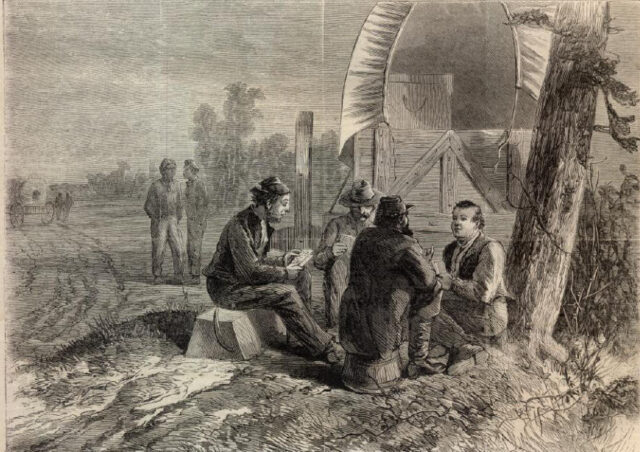November 24, 2024, marks 160 years since Campbellsville experienced the tragedy of the Civil War firsthand.
That morning in 1864 just as most families were finishing breakfast and beginning their workday, 4,000 Union cavalrymen under the command of Gen. Edward Hatch passed through Campbellsville, with orders to encamp about a mile north of the town.
As Union troops scouted westward up Rea Branch, over the ridge a fierce engagement broke out with Confederate forces led by Gen. Abraham Buford.
Sgt. Richard R. Hancock of Company C, 2nd Tennessee Cavalry (CSA), later wrote, “On reaching Campbellsville around noon on the 24th, Buford found in his front about 4,000 Federal cavalry under Gen. Hatch. Our General immediately attacked the enemy with Bell’s Brigade and Huey’s Kentuckians – less than 1,000 men – and maintained a vigorous combat until Gen. [William H.] Jackson arrived. The combined Confederate forces then launched a successful attack, routing the enemy completely.”
As Union forces retreated, Confederate troops advanced, but some Union soldiers regrouped, forming a new defensive line near the Cumberland Presbyterian Church on Locke Road.
Around noon, Confederate Gen. Frank Crawford Armstrong arrived along Dry Creek Road, bringing 800 men with orders to block Gen. Hatch’s retreat route to Lynnville. Soon after, Gen. Lawrence Ross, commanding the Texas Cavalry Regiment, observed the battle from a knoll above the cemetery, exchanging artillery fire with the Union forces for about an hour.
As Union troops fell back from the church line, Gen. Ross led his men in a cavalry charge, galloping through the village along what is now High Street (formerly known as War Street for some time after the battle). Hatch was forced to withdraw his entire force across Big Creek and over the ridge about a mile east of town.
The fighting continued on the eastern side of the ridge, at times turning into intense hand-to-hand combat. By nightfall, the Union forces had been driven all the way to Lynnville.
The Night Before the Battle
We have had a good deal of sharp skirmishing to-day; this evening, before dark, quite spirited. General Croxton’s brigade had the rear on the road from Lawrenceburg. On leaving the camp, three miles from Lawrenceburg, this morning, the skirmishing began. General Croxton reports force attacking his was infantry, and thinks it is the enemy’s advance. We captured two prisoners (infantry) from Stevenson’s division. I look for enemy’s cavalry to-morrow at Campbellsville.
– Communication from Edward Hatch, Brigadier General, which was forwarded to Major General H. W. Halleck in Washington, D. C., by Major-General Thomas on November 23, 1864-10 p.m.

Thanks to the Tennessee Civil War Preservation Association for the document which contained this map here.
Mary Eliza Yokley
The only known civilian casualty of the Battle of Campbellsville was eight-year-old Mary Eliza Yokley. After the fighting had ended, a wounded Confederate soldier accidentally dropped his weapon while trying to dismount his horse in Mary’s front yard. The weapon discharged, striking and killing her. Mary is buried in the Hannah-Yokley family cemetery, about three-quarters of a mile north of Campbellsville.


The Battlefield at the Rear
“The Battlefield at the Rear” was not necessarily sketched at the Battle of Campbellsville, but it was done by artist A.W. Warren for Harper’s Weekly, a publication that chronicled the Civil War, in a weekly publication.
Harper’s Weekly published the sketch with these comments on Dec. 10, 1864, just a couple of weeks after the Battle of Campbellsville.
“The interesting sketch which we give our readers this week on page 796 represents a curious but saddening feature of the battle field. Look at the picture of the battle at the front, where our poor soldiers, battling for the country theirs and ours are risking precious lives, are suffering from severe, if not mortal, wounds, and their blood stains the contested field. Turn then from this picture and look to what is going on in the rear. Here, under shelter of heavy wagons, are teamsters and sutlers, and other noncombatants, playing cards, or engaged in other amusements, as regardless of what is going on a few rods distant at the front what games contested or what problems solved as if they were congregated together at a fair. Between the mimic strife in the rear and the exciting game at the front how short a space, but a contrast of what opposites!”

Through the diligent commitment of The Campbellsville Area Association, the Battle of Campbellsville is included in the Tennessee Civil War Trails program.
The information on this page is brought to you by the Campbellsville Area Association.
